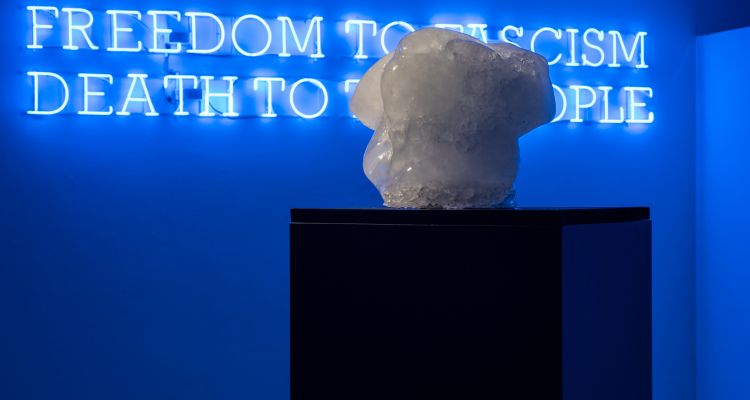Curated by: Bojana Piškur and Kristjan Sedej
A Short Histery of Our Times presents the oeuvre of Maja Bajević, an artist who has figured prominently on the art scene in the region of the former Yugoslavia since the 1990s. Her artistic practice is largely underpinned by the context of the wars in the former common state and by her native Bosnia and Herzegovina.
Most of the featured works have been created specifically for this exhibition. The presentation is rounded off with a number of older works that have been reconsidered and reinstalled in this new context. Through this exhibition, Bajević explores the history of failed revolutionary movements that have brought Western society to its current state of collective impotence to shape a future, and to the pervasive social “hysteria.” Bringing together works realized in a variety of media, the show is divided in three chapters presented in three rooms – the past, the present, and the future.
In the first room, the artist investigates the history of revolutionary initiatives of the 20th century. Her ice sculpture of Karl Marx that keeps melting and reappearing and her sound installation Songs of Love and Squalor – a collage of revolutionary songs that are slowly fading into oblivion – point to the problem of collective amnesia. This social phenomenon makes way for the distortions of historical memory and the relativizations of the political and social achievements of the 20th century. Today, fascist ideologies are laying claim to the key values of antifascism by appropriating and perverting its ideas. Bajević reacts to this with a provocative neon sign FREEDOM TO FASCISM, DEATH TO THE PEOPLE, effectively exposing the absurdity of contemporary turns in political discourse. The persistent reappearances of Marx’s sculpture, on the other hand, open up the possibility of the rebirth of revolutionary antifascist thought and actual political action.
The Noise project in the second room focuses on the present marked by our political reality, interpreted as a collage of divergent terms and slogans from various historical and contemporary political orientations. Viewing language as a means of political and revolutionary mobilization with a degree of cynicism, the artist projects actual and made-up slogans with LED fans. Displayed with these visually dynamic but physically silent devices, the catchphrases underscore the chasm between an individual and the demagogy of political movements. The work also materializes the growing doubt concerning politics as a system of control and exploitation of power over society at large.
The works in the third room draw a dystopic image of the future that the progressive collective amnesia and the unstoppable march of the techno-capitalist system are leading to. In the interior, Bajević creates a cacophony of objects, motions, and sounds that simulate the “hysteria” and chaos of the future. Filled with trash, the room represents a world of growing consumption that is gradually degrading both the social and natural landscapes. The only slogan to be found in this future is the neon sign MORE OR MORE.
A spinning chandelier coming dangerously close to barbed wire enhances the atmosphere of threat and danger projected by this image of the future. Two new video works created for this exhibition explore a future that leaves no room for human advancement. One video focuses on the development of AI and the emergence of human simulacra, while the other – using the looped closing credits of the film What Lies Beneath (2000), where the music keeps building suspense despite the film having clearly ended – critically exposes the inability of Western society to recognize or accept its own end.
Maja Bajević, born in 1967 in Sarajevo, lives and works in Paris. Her multimedia oeuvre comprises a variety of practices that critically and cynically explore social and political themes marking contemporary social awareness and political power. Bajević critically deconstructs the role of women in society, globalization, political exploitation and exclusion, collective memory, and the consequences of neoliberalism. Her works include videos, installations, performances, drawings, and graphic prints. She has exhibited at the Museo Reina Sofía, MAXXI, Moderna Museet, MoMA PS1, and the 50th and 56th Venice Biennales, among other venues. Her works are included in the collections of many museums, including MACBA, Centre George Pompidou, National Gallery of Bosnia and Herzegovina, and Moderna galerija.
